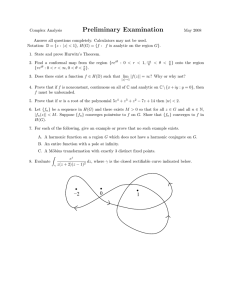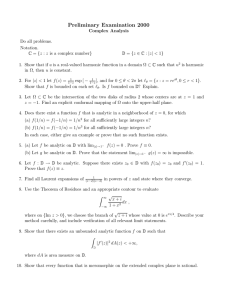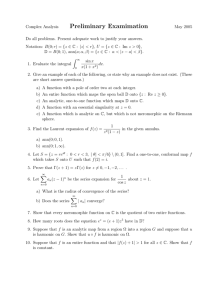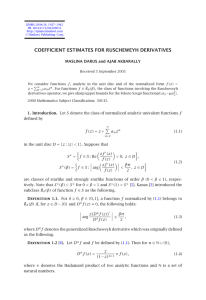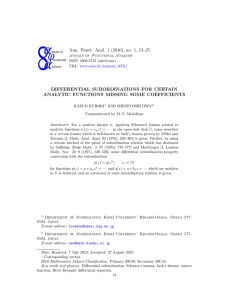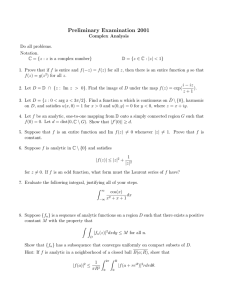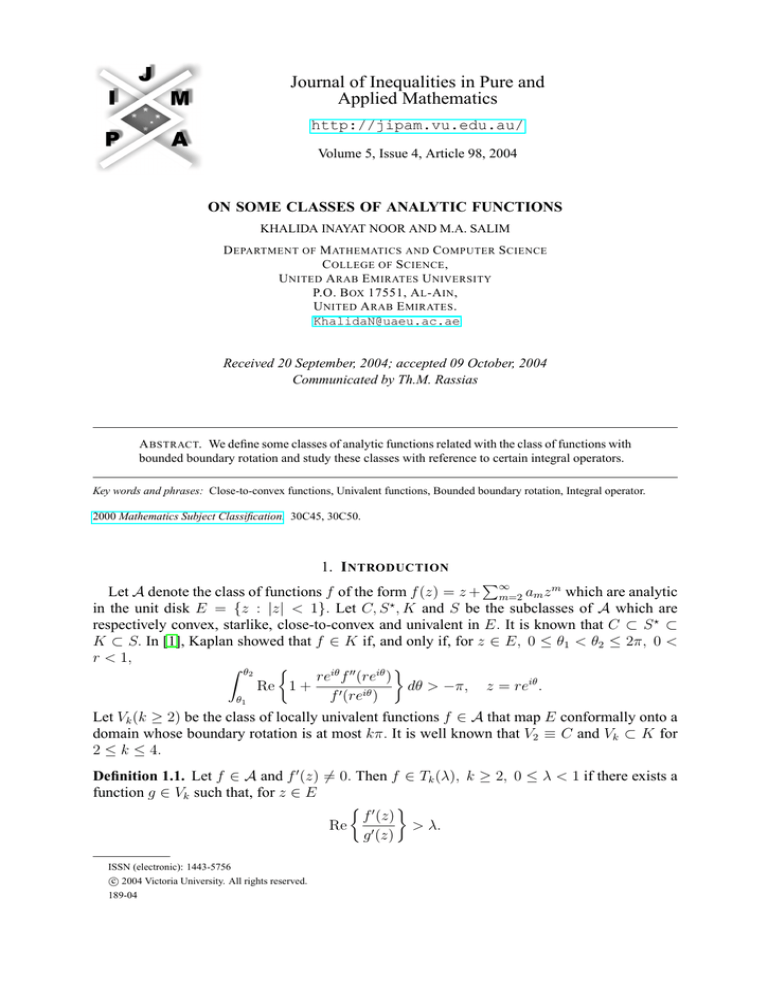
Journal of Inequalities in Pure and
Applied Mathematics
http://jipam.vu.edu.au/
Volume 5, Issue 4, Article 98, 2004
ON SOME CLASSES OF ANALYTIC FUNCTIONS
KHALIDA INAYAT NOOR AND M.A. SALIM
D EPARTMENT OF M ATHEMATICS AND C OMPUTER S CIENCE
C OLLEGE OF S CIENCE ,
U NITED A RAB E MIRATES U NIVERSITY
P.O. B OX 17551, A L -A IN ,
U NITED A RAB E MIRATES .
KhalidaN@uaeu.ac.ae
Received 20 September, 2004; accepted 09 October, 2004
Communicated by Th.M. Rassias
A BSTRACT. We define some classes of analytic functions related with the class of functions with
bounded boundary rotation and study these classes with reference to certain integral operators.
Key words and phrases: Close-to-convex functions, Univalent functions, Bounded boundary rotation, Integral operator.
2000 Mathematics Subject Classification. 30C45, 30C50.
1. I NTRODUCTION
P
m
Let A denote the class of functions f of the form f (z) = z + ∞
m=2 am z which are analytic
?
in the unit disk E = {z : |z| < 1}. Let C, S , K and S be the subclasses of A which are
respectively convex, starlike, close-to-convex and univalent in E. It is known that C ⊂ S ? ⊂
K ⊂ S. In [1], Kaplan showed that f ∈ K if, and only if, for z ∈ E, 0 ≤ θ1 < θ2 ≤ 2π, 0 <
r < 1,
Z θ2
reiθ f 00 (reiθ )
Re 1 +
dθ > −π, z = reiθ .
0
iθ
f (re )
θ1
Let Vk (k ≥ 2) be the class of locally univalent functions f ∈ A that map E conformally onto a
domain whose boundary rotation is at most kπ. It is well known that V2 ≡ C and Vk ⊂ K for
2 ≤ k ≤ 4.
Definition 1.1. Let f ∈ A and f 0 (z) 6= 0. Then f ∈ Tk (λ), k ≥ 2, 0 ≤ λ < 1 if there exists a
function g ∈ Vk such that, for z ∈ E
0 f (z)
Re
> λ.
g 0 (z)
ISSN (electronic): 1443-5756
c 2004 Victoria University. All rights reserved.
189-04
2
K HALIDA I NAYAT N OOR AND M.A. S ALIM
The class Tk (0) = Tk was considered in [2, 3] and T2 (0) = K, the class of close-to-convex
functions.
0
Definition 1.2. Let f ∈ A and f (z)fz (z) 6= 0, z ∈ E. Then f ∈ Tk (a, γ, λ), Re a ≥ 0, 0 ≤ γ ≤
1 if, and only if, there exists a function g ∈ Tk (λ) such that
(1.1)
zf 0 (z) + af (z) = (a + 1)z(g 0 (z))γ ,
z ∈ E.
We note that Tk (0, 1, λ) = Tk (λ) and T2 (0, 1, λ) = K(λ) ⊂ K, and it follows that f ∈
Tk (a, γ, λ) if, and only if, there exists F ∈ Tk (∞, γ, λ) such that
Z
a + 1 z a−1
t F (t)dt.
f (z) =
za
0
2. P RELIMINARY R ESULTS
Lemma 2.1 ([2]). Let f ∈ A. Then, for 0 ≤ θ1 < θ2 ≤ 2π, z = reiθ , 0 < r < 1, f ∈ Tk if
and only if
0
Z θ2
k
zf (z))0
Re
dθ > − π.
0
f (z)
2
θ1
Lemma 2.2. Let q(z) be analytic in E and of the form q(z) = 1 + b1 z + · · · for |z| = r ∈ (0, 1).
Then, for a, c1 , θ1 , θ2 with a ≥ 1, Re(c1 ) ≥ 0, 0 ≤ θ1 < θ2 ≤ 2π,
Z θ2
azq 0 (z)
Re q(z) +
dθ > −β1 π;
(0 < β1 ≤ 1)
c1 a + q(z)
θ1
implies
Z
θ2
Re q(z)dθ > −β1 π,
z = reiθ .
θ1
This result is a direct consequence of the one proved in [4] for β1 = 1.
From (1.1) and Lemma 2.1, we can easily have the following:
Lemma 2.3. A function f ∈ Tk (∞, γ, λ) if and only if, it may be represented as f (z) =
p(z) · zG0 (z), where G ∈ Vk and Re p(z) > λ, z ∈ E.
Proof. Since f ∈ Tk (∞, γ, λ), we have
f (z) = z(g 0 (z))γ ,
=z
g ∈ Tk (λ)
γ
[G01 (z)p1 (z)]
0
, G1 ∈ Vk , Re p1 (z) > λ
= zG (z).p(z),
where G0 (z) = (G01 (z))γ ∈ Vk and p(z) = (p1 (z))γ , Re p(z) > λ, since 0 ≤ γ ≤ 1.
The converse case follows along similar lines.
Using Lemma 2.1 and Lemma 2.3, we have:
Lemma 2.4.
(i) Let f ∈ Tk (0, γ, λ). Then, with z = reiθ , 0 ≤ θ1 < θ − 2 ≤ 2π,
Z θ2
(zf 0 (z))0
kγ
Re
dθ > − , see also [3].
0
f (z)
2
θ1
(ii) Let f ∈ Tk (∞, γ, λ). Then, for z = reiθ and 0 ≤ θ1 < θ2 ≤ 2π,
0 Z θ2
zf (z)
kγ
Re
dθ > − .
f (z)
2
θ1
J. Inequal. Pure and Appl. Math., 5(4) Art. 98, 2004
http://jipam.vu.edu.au/
C LASSES O F A NALYTIC F UNCTIONS
3
3. M AIN R ESULTS
Theorem 3.1. For 0 < α <
E, let
1
,
1−λ+λβ
0<β<
λ
,
1−λ
0≤λ<
1
2
and f, g ∈ Tk (∞, γ, λ), z ∈
1
1+β
Z z 1
1
−2
1− α
1
F (z) =
β+
z
t α (f (t))β g(t)dt
.
α
0
(3.1)
Then F1 , with F = zF10 and 0 < γ < 1, k ≤ γ2 , is close-to-convex and hence univalent in E.
Proof. We can write (3.1) as
β+1
(F (z))
(3.2)
=
1
β+
α
z
1
1− α
Z
z
1 −2
t α (f (t))β g(t)dt.
0
Let
zF 0 (z)
(zF10 (z))0
=
= (1 − λ)H(z) + λ,
F (z)
F10 (z)
(3.3)
where H(z) is analytic in E and H(z) = 1 + c1 z + c2 z 2 + · · · .
We differentiate (3.2) logarithmically to obtain
1 −1
zF 0 (z)
1
z α (f (z))β g(z)
(β + 1)
= 1−
+ R z 1 −2
.
α
F (z)
α
β (t)g(t)dt
t
(f
(z))
0
Using (3.2) and differentiating again, we have after some simplifications,
(1 − λ)zH
Rz
0 0
1 −2
t α (f (t))β g(t)dt
1 −1
+ (1 − λ)H(z)
z α (f (z))β g(z)
β
zf 0 (z)
1
zg 0 (z)
=
·
+
·
− λ.
1 + β f (z)
β + 1 g(z)
Now
1 −1
z α (f (z))β g(z)
Rz
0
1 −2
=
t α (f (t))β g(t)dt
1
zF 0 (z)
− 1 + (1 + β)
.
α
F (z)
Hence
−λ+
β
zf 0 (z)
1
zg 0 (z)
·
+
·
1 + β f (z)
β + 1 g(z)
= (1 − λ)H(z) +
(1 − λ)zH 0 (z)
(1 − λ)(1 + β)H(z) + ( α1 − 1) + λ(1 + β)
and we have
(3.4)
0
0
1
β
zf (z)
1
zg (z)
−λ +
−λ
1−λ 1+β
f (z)
1+β
g(z)
= H(z) +
1
zH 0 (z)
(1+β)(1−λ)
H(z) +
J. Inequal. Pure and Appl. Math., 5(4) Art. 98, 2004
h
1
(α
−1)
(1+β)(1−λ)
+
λ
1−λ
i.
http://jipam.vu.edu.au/
4
K HALIDA I NAYAT N OOR AND M.A. S ALIM
Since f, g ∈ Tk (∞, γ, λ), so with z = reiθ , 0 ≤ θ1 < θ2 ≤ 2π,
0
Z θ2
1
zf (z)
β
Re
−λ
dθ
1 + β θ1
1 − λ f (z)
0
Z θ2
zg (z)
1
1
−kγ
+
Re
−λ
dθ >
π,
1 + β θ1
1 − λ g(z)
2
and, therefore,
Z
θ2
Re H(z) +
H(z) +
θ1
Now using Lemma 2.2 with a =
the required result.
1
zH 0 (z)
(1+β)(1−λ)
n
1
(1+β)(1−λ)
1
−1)
(α
(1+β)(1−λ)
≥ 1, c1 =
+
λ
1−λ
1
α
o dθ >
−kγ
π.
2
− 1 + (1 + β)λ ≥ 0, we obtain
Theorem 3.2. Let f, g ∈ Tk (∞, γ, λ), α, c, δ and ν be positively real, 0 < α ≤
α(1 − λ), (ν + δ) = α. Then the function F defined by
Z z
α
α−c
(c−δ−ν)−1
δ
ν
(3.5)
[F (z)] = cz
t
(f (t)) (g(t)) dt
1
,
1−λ
c >
0
belongs to Tk (∞, γ, λ) for k ≤
2
,
γ
0 < γ < 1.
Proof. First we show that there exists an analytic function F satisfying (3.5).
Let
G(z) = z −(ν+δ) (f (z))δ (g(z))ν
= 1 + d1 z + d2 z 2 + · · ·
and choose the branches which equal 1 when z = 0. For
K(z) = z
(c−ν−δ)−1
δ
ν
(f (z)) (g(z)) = z
c−1
G(z),
we have
Z
c z
c
L(z) = c
K(t)dt = 1 +
d1 z + · · · .
z 0
1+c
Hence L is well-defined and analytic in E.
Now let
1
α
α1
α
F (z) = z L(z) = z [L(z)] ,
1
where we choose the branch of [L(z)] α which equals 1 when z = 0. Thus F is analytic in E
and satisfies (3.5).
Set
zF 0 (z)
(3.6)
= (1 − λ)h(z) + λ,
F (z)
and let
zf 0 (z)
= (1 − λ)h1 (z) + λ
f (z)
zg 0 (z)
= (1 − λ)h2 (z) + λ.
g(z)
J. Inequal. Pure and Appl. Math., 5(4) Art. 98, 2004
http://jipam.vu.edu.au/
C LASSES O F A NALYTIC F UNCTIONS
5
Now, from (3.5), we have
h (c−δ−ν)−1
i
zF 0 (z)
(3.7)
z
[F (z)] (c − α) + α
=c z
(f (z))δ (g(z))ν .
F (z)
We differentiate (3.7) logarithmically and use (3.6) to obtain
zh0 (z)
α(1 − λ) h(z) +
+ (δ + ν − α)
(c − α) + α{λ + (1 − λ)h(z)}
zf 0 (z)
zg 0 (z)
+ν
− αλ
=δ
f (z)
g(z)
0
0
zg (z)
zf (z)
=δ
−λ +ν
−λ .
f (z)
g(z)
This gives us
zh0 (z)
h(z) +
(c − α) + α{λ + (1 − λ)h(z)}
0
0
δ
zf (z)
ν
zg (z)
=
−λ +
−λ .
α(1 − λ) f (z)
α(1 − λ) g(z)
(c−α)
α
Since f, g ∈ Tk (∞, γ, λ), we have, for 0 ≤ θ1 < θ2 ≤ 2π, z = reiθ ,
Z θ2
zh0 (z)
dθ
Re h(z) +
(c − α) + α{λ + (1 − λ)h(z)}
θ1
Z θ2
Z
δ
ν θ2
=
Re h1 (z)dθ +
Re h2 (z)dθ
α θ1
α θ1
γk
ν
γk
δ
− π +
− π
>
α
2
α
2
δ+ν
γk
γk
=
− π = − π,
α
2
2
where we have used Lemma 2.4.
1
1
Now using Lemma 2.2 with a = α(1−λ)
> 1, for α < 1−λ
and
c1 = c − α + αλ = c − α(1 − λ) ≥ 0,
we obtain the required result.
R EFERENCES
[1] W. KAPLAN, Close-to-convex Schlicht functions, Michigan Math. J., (1952), 169–185.
[2] K.I. NOOR, On a generalization of close-to-convexity, Intern. J. Math. & Math. Sci., 6 (1983), 327–
334.
[3] K.I. NOOR, Higher order close-to-convex functions, Math. Japonica, 37 (1192), 1–8.
[4] R. PARVATHAN
(1988), 31–34.
AND
S. RADHA, On certain classes of analytic functions, Ann. Polon. Math., 49
J. Inequal. Pure and Appl. Math., 5(4) Art. 98, 2004
http://jipam.vu.edu.au/


